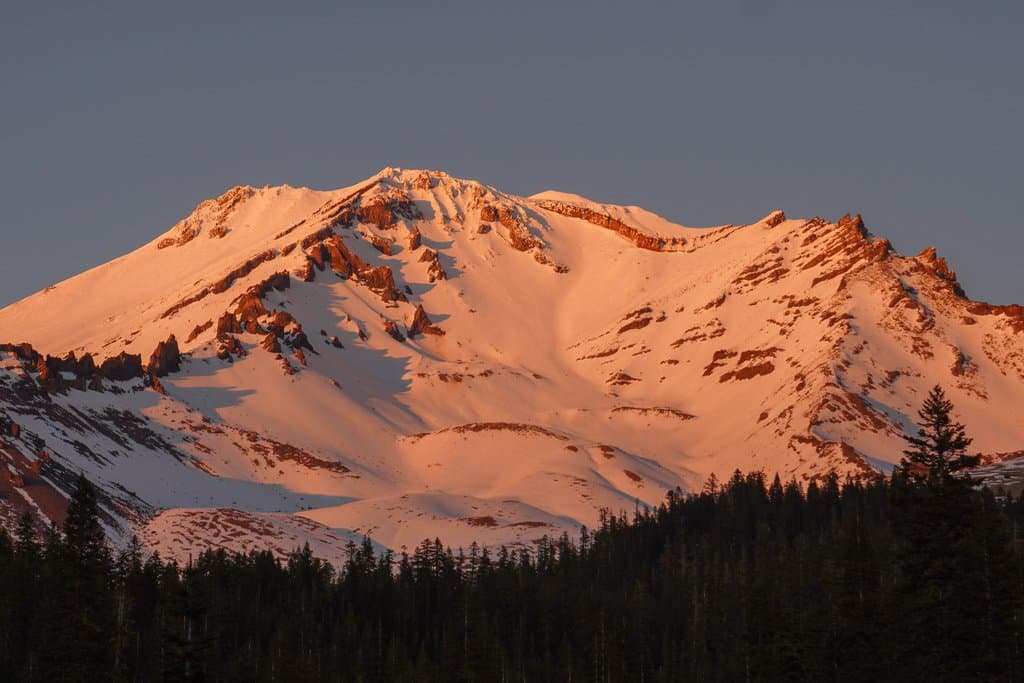
Report from 2nd and 3rd December and written by Blackbird Mountain Guides
- Where: Mount Shasta from Bunny Flat Trailhead
- When: December 2 & 3, 2021
- What: Skied Trinity Chutes & Upper Ski Bowl
- Vertical: 6,000’ Day 1, 4,700’ Day 2
- Snow Surface: Corn, and excellent quality
The corn skiing on Mount Shasta over the two days was some of the best spring skiing I’ve done in a long time. And, yes, I know it’s not spring at all. It is December… even though it feels like May. No matter: in California, corn snow can develop in what seems like a matter of minutes, and we were there to reap the rewards of this quick-changing snowpack. We skied two days, December 2 and 3.

It’s definitely California adventure skiing, with its share of dirt patches and rocks, but it wasn’t even significant enough to warrant packing running shoes for the approach. Currently, skinning starts a quarter-mile from the trailhead. There are patches of dirt that are difficult to avoid, so bring your rock skins (which, if you backcountry skied in California this past spring, you surely own at least one pair of). This length will increase as sun, warmth, and time deplete the meager, low-elevation snowpack.

Once you are above treeline in Avalanche Gulch, the snow is consistent, supportable, and fully transitioned corn. It was grippy for skinning and supportable in most places for cramponing. We were able to skin above Helen Lake to the lower reaches of the Heart before we transitioned to crampons and axes.
The main hazards in the gulch are currently rock and icefall from the Red Banks and the Trinity Chutes. As early as 9 am, the rocks were zinging down the slopes from the cliffs above, and rime was starting to detach, sending plates of ice zinging down. This hazard was most pronounced starting above Helen Lake at the bottom of the Heart. We opted to climb towards the Thumb, where there was less rime. The hazard was less, but still there. Start early to avoid these problems!

Day one: The Trinity Chutes. Grippy but firm snow made for excellent and efficient skinning, and we could skin to the bottom of the Heart. We transitioned to crampons here, making the transition as quickly as possible to minimize the overhead hazard. Climbing conditions were excellent for the most part, with only short sections of punchy snow. Sometimes we had to look for firmer areas, but generally, we found supportable snow and easy climbing.
Misery Hill was heavily rimed, with blue ice chicken heads on the flats leading to the hill, making it difficult to skin even the low-angle terrain. Based on our timing and the conditions above the Red Banks, we opted to ski down instead of summiting.
The timing was tough. The chutes, starting at roughly 13k’, were a little hard to read, and there was certainly some firm snow there. We dropped in before 3:00 pm and found soft snow throughout the upper section of the chutes. The tradeoff was rime was peeling from the rocks, so we skied it fast to minimize our exposure time. There was some firm and loud snow up high in the more easterly tilted panels even at this late hour. It was still very edgeable but not as enjoyable.
By 12,000’ everything was skiing well. The snowpack was well frozen with a nice layer of softened corn on the surface. The lower elevations skied even better. With more diurnal cycling down low and lower sun angle, the skiing was even faster and more consistent – perfect Mount Shasta conditions and one of the reasons Shasta is renowned for its corn.

Day two: Upper Ski Bowl. We couldn’t resist the upper Ski bowl on day two. The aesthetic line had the perfect aspect to deliver another excellent day of Mount Shasta corn skiing, and we were drooling for it.
This approach was much less exposed to overhead rockfall and icefall hazards. We skinned up Avalanche Gulch, then ascended Green Butte ridge to the Upper Ski Bowl. Excellent cramponing here, with some very firm snow surfaces.
We skied from the top of the snow at 11,700’ where the ridge above Green Butte meets Sargent’s Ridge. We started earlier here, around 1 pm. Some of the snow was still a little firm, and some was a little soft, but as we descended to about 10,500’, it was excellent. We skied back to the ridge and ducked back into Avalanche Gulch to return to Bunny Flat. The snow here was still firm but edgeable at this point. The turns to the bottom were excellent.
All in all, a thoroughly worthwhile adventure and shockingly good skiing. It was still in the realm of solid Type-1 Fun, and with only a quarter of a mile of dirt walking, it’s not necessary to take shoes.
Overall, the conditions are excellent for skiing or climbing right now. As long as the winds stay low and temps are similar (45F at 8,000′), you should get similar conditions on the mountain until the next storm. If you’re not into adventure skiing but still want to explore the mountain, climbing conditions are better than they would have been in peak climbing season this year. Come out and join us!